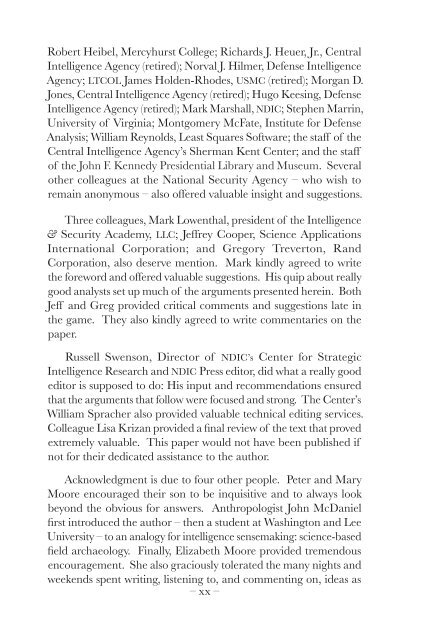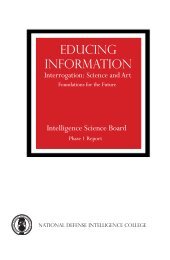Critical Thinking and Intelligence Analysis
Critical Thinking and Intelligence Analysis
Critical Thinking and Intelligence Analysis
Create successful ePaper yourself
Turn your PDF publications into a flip-book with our unique Google optimized e-Paper software.
Robert Heibel, Mercyhurst College; Richards J. Heuer, Jr., Central<br />
<strong>Intelligence</strong> Agency (retired); Norval J. Hilmer, Defense <strong>Intelligence</strong><br />
Agency; LTCOL James Holden-Rhodes, USMC (retired); Morgan D.<br />
Jones, Central <strong>Intelligence</strong> Agency (retired); Hugo Keesing, Defense<br />
<strong>Intelligence</strong> Agency (retired); Mark Marshall, NDIC; Stephen Marrin,<br />
University of Virginia; Montgomery McFate, Institute for Defense<br />
<strong>Analysis</strong>; William Reynolds, Least Squares Software; the staff of the<br />
Central <strong>Intelligence</strong> Agency’s Sherman Kent Center; <strong>and</strong> the staff<br />
of the John F. Kennedy Presidential Library <strong>and</strong> Museum. Several<br />
other colleagues at the National Security Agency – who wish to<br />
remain anonymous – also offered valuable insight <strong>and</strong> suggestions.<br />
Three colleagues, Mark Lowenthal, president of the <strong>Intelligence</strong><br />
& Security Academy, LLC; Jeffrey Cooper, Science Applications<br />
International Corporation; <strong>and</strong> Gregory Treverton, R<strong>and</strong><br />
Corporation, also deserve mention. Mark kindly agreed to write<br />
the foreword <strong>and</strong> offered valuable suggestions. His quip about really<br />
good analysts set up much of the arguments presented herein. Both<br />
Jeff <strong>and</strong> Greg provided critical comments <strong>and</strong> suggestions late in<br />
the game. They also kindly agreed to write commentaries on the<br />
paper.<br />
Russell Swenson, Director of NDIC’s Center for Strategic<br />
<strong>Intelligence</strong> Research <strong>and</strong> NDIC Press editor, did what a really good<br />
editor is supposed to do: His input <strong>and</strong> recommendations ensured<br />
that the arguments that follow were focused <strong>and</strong> strong. The Center’s<br />
William Spracher also provided valuable technical editing services.<br />
Colleague Lisa Krizan provided a final review of the text that proved<br />
extremely valuable. This paper would not have been published if<br />
not for their dedicated assistance to the author.<br />
Acknowledgment is due to four other people. Peter <strong>and</strong> Mary<br />
Moore encouraged their son to be inquisitive <strong>and</strong> to always look<br />
beyond the obvious for answers. Anthropologist John McDaniel<br />
first introduced the author – then a student at Washington <strong>and</strong> Lee<br />
University – to an analogy for intelligence sensemaking: science-based<br />
field archaeology. Finally, Elizabeth Moore provided tremendous<br />
encouragement. She also graciously tolerated the many nights <strong>and</strong><br />
weekends spent writing, listening to, <strong>and</strong> commenting on, ideas as<br />
– xx –
















